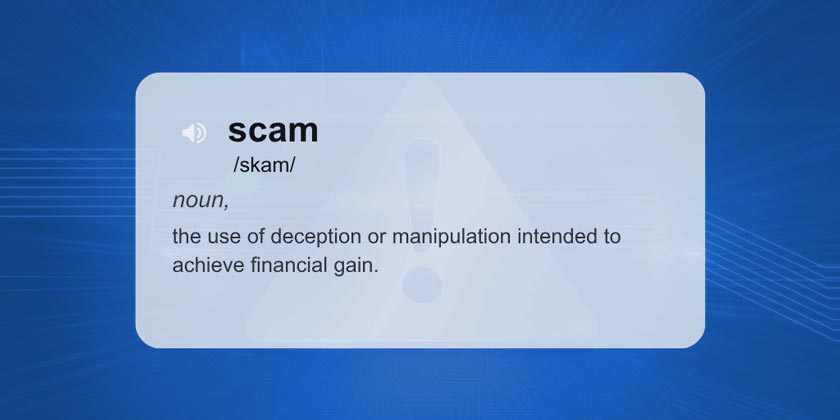What are Scams?
Scams targeting consumers and businesses are increasingly in the news these days. However, people often use the words “scam” and “fraud” interchangeably, which can be confusing. The Federal Reserve, financial institutions, technology providers and other organizations see clear value in differentiating these terms and types of incidents.
With the goal of providing a more consistent foundation for reporting as a basis to better understand and mitigate scams, the Federal Reserve convened an industry work group of payments and fraud experts in 2023. The industry work group developed and published the following operational definition of a scam:

Scams have been around for thousands of years. However, they have become increasingly sophisticated in recent years, resulting in billions of dollars of losses. Many believe this can’t happen to them, despite prevalent news reports, ongoing education and awareness efforts. Whether you believe you will fall victim or not, it is important to be aware of what is happening.
Why You Should Care About Scams
- Scams don’t discriminate
- The financial cost is overwhelming
- Stolen money fuels organized crime
- They inflict an emotional and psychological toll
- Scams undermine society and organizations
- Knowledge is power to identify scams
- You can be a line of defense
Common Examples of Scams
- Impostors
- Merchandise
- Business and job opportunities
- Investments
- Internet services

How Scams Occur: The Basic Steps
- The Setup: Targeting the Victim
- Building Trust
- The Hook: Asking for Something
- The Exit: Vanishing Act
- Repetition or Retargeting
The Allure of Scams
Scams are successful when they offer what we want. The appeal of having more money, making a romantic connection or avoiding negative consequences are examples of the types of emotional manipulation used in scams. People are compelled to respond or act based on the urgency and pressure created. By impersonating a legitimate business, organization or agency, scam requests often appear to be standard communications sent by trusted and authoritative sources. People may think they can’t be scammed — but that belief was shared by many scam victims who lost money and had to deal with the financial and emotional impacts.
Downloadable Resources
Explore these resources for additional information on scams basics.
| Document Title | Format | Reading Time |
|---|---|---|
| An Operational Scam Definition (PDF) | Document | 1 minutes |
| Why You Should Care About Scams (PDF) | Document | 3 minutes |
| How Scams Occur (PDF) | Document | 3 minutes |
| The Allure of Scams (PDF) | Document | 3 minutes |
The scams mitigation toolkit was developed by the Federal Reserve to help educate the industry about scams and outline potential ways to help detect and mitigate this fraud type. Insights for this toolkit were provided through interviews with industry experts, publicly available research, and team member expertise. This toolkit is not intended to result in any regulatory or reporting requirements, imply any liabilities for fraud loss, or confer any legal status, legal definitions, or legal rights or responsibilities. While use of this toolkit throughout the industry is encouraged, utilization of the toolkit is voluntary at the discretion of each individual entity. Absent written consent, this toolkit may not be used in a manner that suggests the Federal Reserve endorses a third-party product or service.

